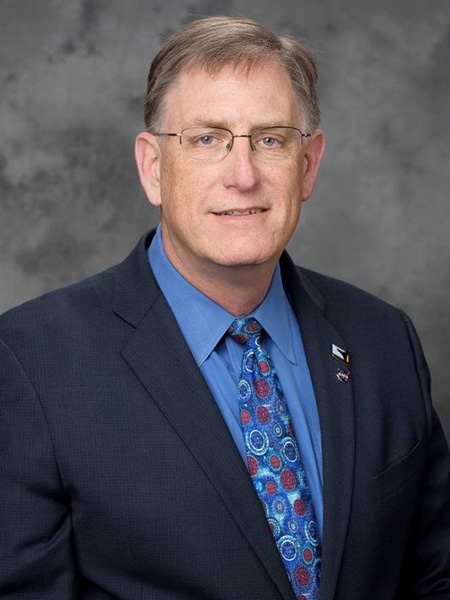Daniel Dumbacher
Daniel Dumbacher
Professor of Engineering Practice, Aeronautics and Astronautics, Purdue University
BSME 1981
Daniel Dumbacher’s career has been marked by sustained leadership, innovation and a steadfast commitment to advancing the aerospace industry for the benefit of society.
From 2018 to 2024, he served as the chief executive officer of the American Institute of Aeronautics and Astronautics (AIAA), where he implemented aeronautic, space, and research and development strategic domain constructs to enhance impact and grow membership. He established new engagement mechanisms for student branches, sections, and corporate and professional members, and he launched a new conference event that brought in 200 new companies.
Prior to AIAA, he was a professor of engineering practice at Purdue for four years, carrying on the principles that he learned as a student and earning the coveted W. A. Gustafson Teaching Award in the School of Aeronautics and Astronautics. He received the School of Mechanical Engineering’s Outstanding Mechanical Engineer Award in 2003. Now, Dumbacher has returned to Purdue University as a professor of practice, reinstated his consulting company and taken on the part-time role of chief innovation and strategy officer at Special Aerospace Services.
“The Purdue technical foundation is second to none, and the Purdue ‘can do’ spirit is unique to Purdue grads,” Dumbacher said. “Across the aerospace industry, people look to Purdue grads to take on the toughest challenges because they know the Purdue mentality will solve the difficult challenges and make the needed progress.”
In fact, that exact situation happened to him when he was working on the Space Shuttle Main Engine at NASA. He immediately used the thermal and heat transfer skills he’d learned at Purdue, saying, “They were essential to develop the math models and to assess and analyze the test and flight data. Following an SSME ground test failure, the technical leadership specifically looked at me as being ‘closer to the books’ to help resolve a debate on the state of the internal engine fluid flow at the time of the engine failure.”
Dumbacher’s extensive resume at NASA is loaded with instrumental roles in which he developed groundbreaking launch vehicles, spacecraft and the technologies that power them.
Some of his proudest career achievements include being part of the team that initiated the X-37 program, which now is a major asset for the U.S. Air Force, and his involvement with the Delta Clipper Experimental project that produced the first vertical landing cryogenic rocket in the United States in the mid-1990s — “directly leading to the expertise and results we now see with Blue Origin and SpaceX,” he said.
In his role as deputy associate administrator of NASA’s Human Exploration and Operations Mission Directorate, he led a team of 5,000 people and managed a budget of $3 billion to initiate the Artemis campaign. “Developing the human exploration program to the Moon and Mars was extremely challenging and well worth it for the future of society.”
Another key milestone at NASA was managing the 2nd Generation Reusable Launch Vehicle Program, which pioneered cost-effective, reusable spacecraft concepts, resulting in the Orbital Space Plane program.
Dumbacher’s commitment to the future of the aerospace industry is evidenced through his volunteerism as a student mentor, participation as an advisory board member for the Purdue-led Resilient ExtraTerrestrial Habitat Institute, and service as chair of the Purdue Cislunar Advisory Board.
He lauds Purdue Professors Bob Osborne (1924-2009) and Mel L’Ecuyer, who Dumbacher said raised the bar for all of their students.
“They challenged us to think through the subject material and, at the same time, were available to help us work through the obstacles.”
Career Highlights
| 2025–present | Professor, Engineering Practice, Aeronautics and Astronautics, Purdue University |
|---|---|
| 2024–present | Chief Innovation and Strategy Officer, Special Aerospace Services, LLC |
| 2024–present | Chief Executive Officer, Saturn 6 Consulting |
| 2018–2024 | Chief Executive Officer, American Institute of Aeronautics and Astronautics |
| 2014–2018 | Professor, Engineering Practice, Aeronautics and Astronautics, Purdue University |
| 2014–2018 | Chief Executive Officer, Saturn 6 Consulting |
| 2010–2014 | Deputy Associate Administrator, Exploration Systems Development and Human Explorations and Operations Mission Directorate, NASA Headquarters, Washington, D.C. |
| 2007–2010 | Director, Engineering, NASA Marshall Space Flight Center – Huntsville, AL |
| 2005–2007 | Deputy Manager, Ares Launch Vehicle Project, NASA |
| 2005–2005 | Deputy Director, Product Assurance, Safety and Mission Assurance, NASA |
| 2002–2004 | Manager, X-37 Project, NASA |
| 2001–2002 | Deputy Manager, Space Launch Initiative and Orbital Space Plane, NASA |
| 2000–2001 | Manager, Second Generation Reusable Launch Vehicle Program, NASA |
| 1999–2000 | Manager, Structures, Mechanics and Thermal Department, NASA Marshall Space Flight Center |
| 1996–1999 | Deputy Manager, X-33 Program, Lockheed Martin |
| 1994–1996 | Manager and Chief Engineering, Delta Clipper Experimental Project, NASA |
| 1992–1994 | Assistant Manager, Space Shuttle Main Engine Project, NASA Headquarters |
| 1991–1992 | Project Director, Space Shuttle Main Engine Project, NASA Headquarters |
| 1989–1991 | Manager, Technology Test Bed Project, NASA |
| 1987–1989 | Chief Engineer, Space Shuttle Main Engine Alternate Turbopump Project, NASA Marshall Space Flight Center |
| 1985–1987 | Lead, Vehicle Integration, Exoatmospheric Reentry Interceptor System, Teledyne Brown Engineering |
| 1981–1985 | Engineer Systems Analyst, Propulsion Laboratory, NASA Marshall Space Flight Center |
| 1981–1981 | Thermal Analyst, Lockheed Engineering and Technical Services |
Education
| 1981 | BS Mechanical Engineering, Purdue University |
|---|---|
| 1984 | MBA, University of Alabama – Huntsville |

